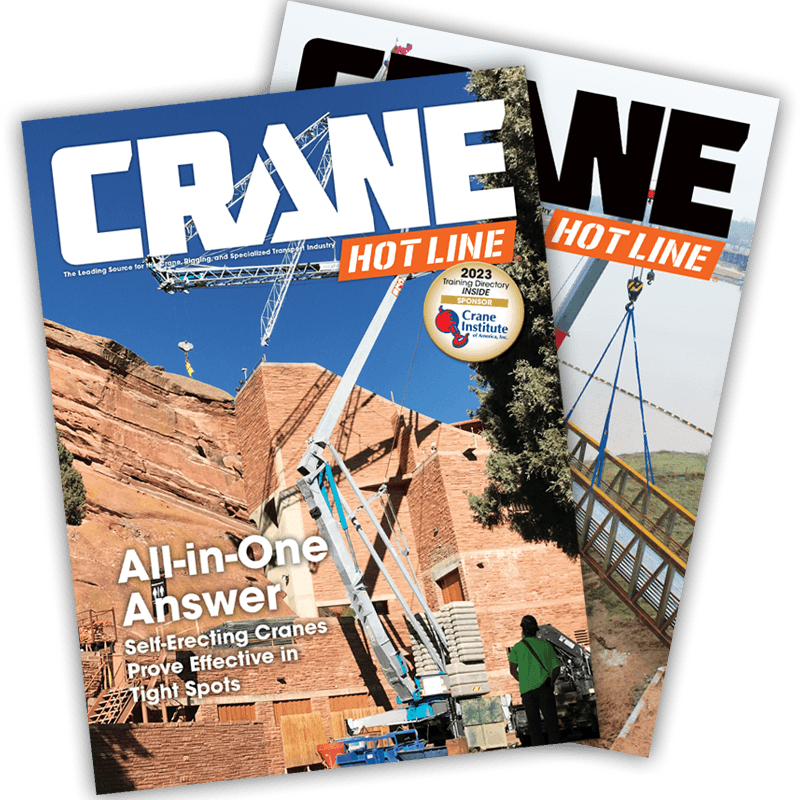Rising Recognition
Fast setup, long reach and small footprints keep earning more fans for self-erectors.
Builders who need to place materials for low- to mid-rise buildings now have more options than ever when it comes to self-erecting tower cranes.
These amazing rigs are usually designed to arrive at a jobsite folded up and sitting on a lowboy trailer or riding on their own axles while being towed by a semi tractor.
Once on site, their supporting outriggers are swung out and leveled before the tower and boom unfold, many times with just the touch of a button.
After the crane’s counterweights are stacked, it’s ready to start lifting.
That few-hour setup plus their ability to sit right next to a building and reach far across it to deliver loads right to where they’re used helps builders do more work in less time with a smaller crew.
Though self-erectors have been popular in Europe for decades, Potain claims to have sold the first one in the U.S. in 2005.
Over the past 20 years, self-erectors have grown steadily more popular as builders and rental companies have increasingly realized their benefits.
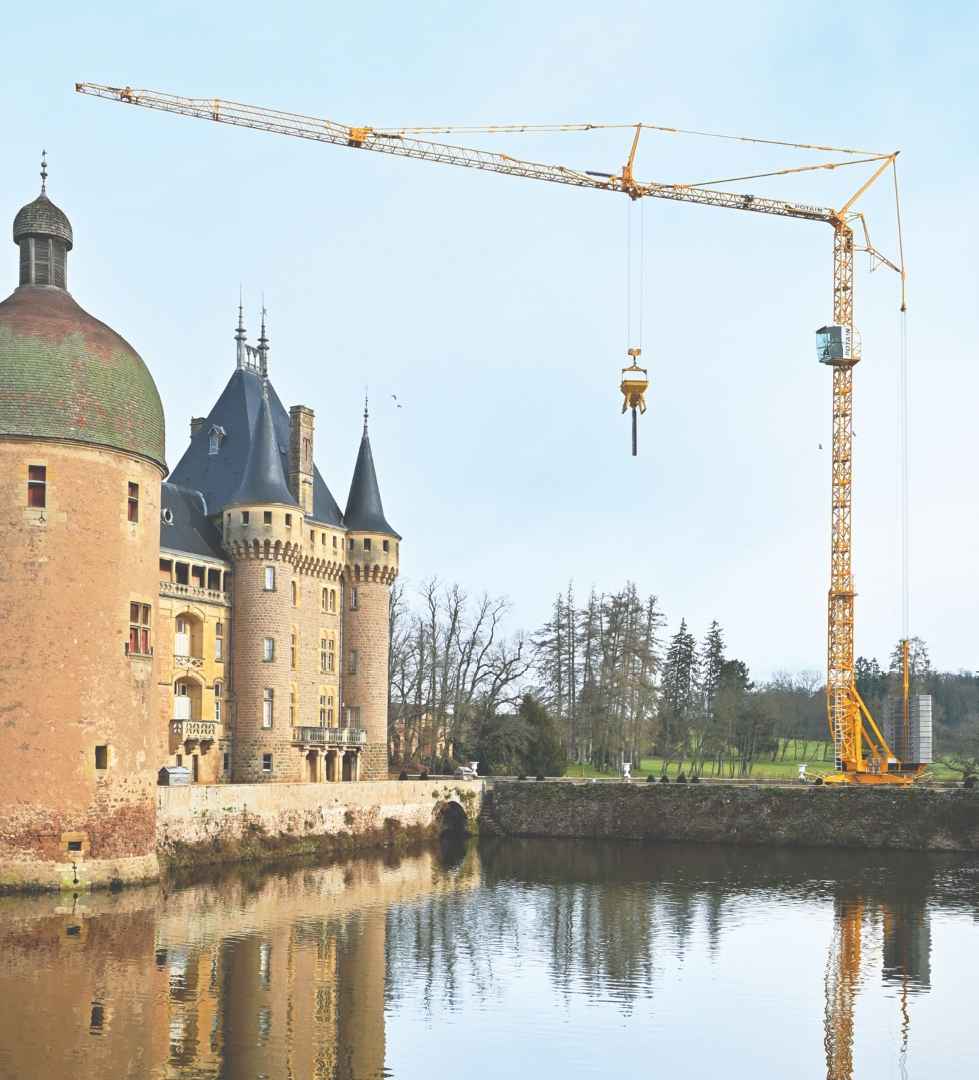
Many Choices
Today, U.S. and Canadian users can choose from a total of 36 self-erector models offered by six manufacturers.
Alphabetically, those manufacturers are: Arcomet (4 models), FB Gru (3), Liebherr (7), Potain (11), Saez (4) and Terex (7).
The overall self-erector field offers maximum lifting capacities from 2,000 to 17,640 pounds, maximum jib lengths from 72 to 180.5 feet, maximum under-hook heights from 58 to 214 feet and capacities from 1,102 to 3,200 pounds at the tip of the longest jib.
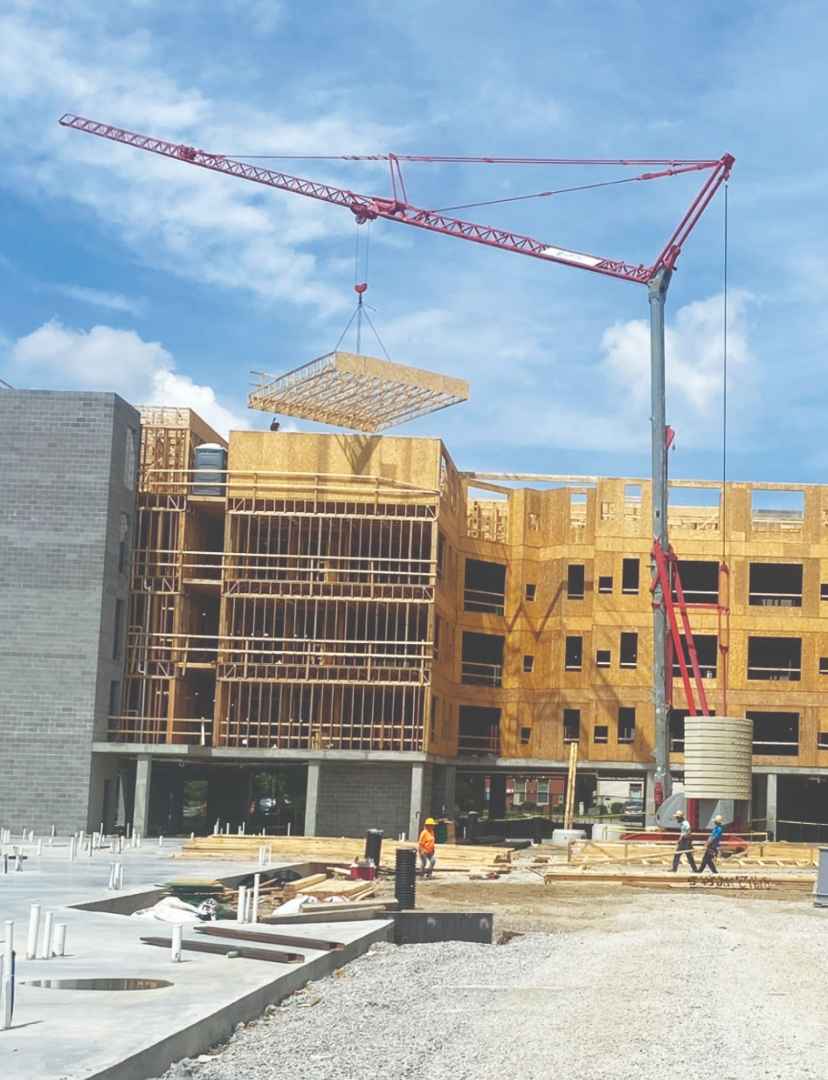
Belgian manufacturer Arcomet is part of the Uperio Group, a French company whose U.S. subsidiaries are Uperio USA and Compass Equipment, a crane rental and sales company with four locations in the western U.S.
Both companies are dealers for Arcomet. In addition, Compass is a dealer for Potain self-erectors and operates a rental fleet of Potain self-erectors and top-slewing tower cranes.
The four Arcomet models are the A40 (8,820-pound capacity, 131-foot jib), A45 Eco City (11,020-pound capacity, 147-foot jib), A47 Eco City (13,230-pound capacity, 154-foot jib) and the A50 (17,640-pound capacity, 164-foot jib).
FB Gru self-erectors are manufactured in Italy and sold and supported in the U.S. by dealer Creative Lifting Services, which is looking for sub-dealers to join the FB Gru support team here.
The three FB Gru models currently sold here are the FB 1179 (3,968-pound capacity, 79-foot jib), FB 1589 (5,511-pound capacity, 89-foot jib) and FB 22141 (8,848-pound capacity, 141-foot jib).
Liebherr offers nine models of self-erecting cranes in North America through its Liebherr USA subsidiary and tower crane dealer Morrow Equipment.
Liebherr’s models include the 25L (5,512-pound capacity, 72-82-foot jib), 25L (5,512-pound capacity, 72.2-88.6-foot jib), 33L (8,818-pound capacity, 82-98.4-foot jib), 43K (3,637-pound capacity, 80.4-114.8-foot jib), 61K (4,630-pound capacity, 91.9-142.1-foot jib), 91K (6,460-pound capacity, 101.7-157.5-foot jib) and 125K (17,637-pound capacity, 114.8-180.5-foot jib).
Liebherr’s newest offering is the 91K, which was introduced at bauma 2025 and will replace the 81K.1.
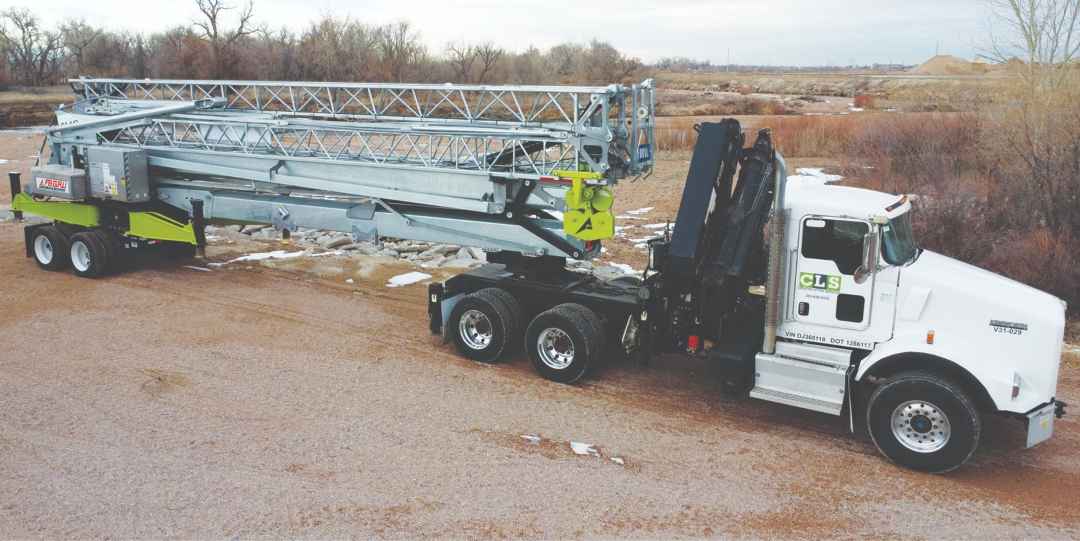
Potain, part of the Manitowoc family of brands, sells and supports 11 self-erector models in North America.
Its offerings include the Igo MA 21 (3,960-pound capacity, 85-foot jib), Hup M 28-22 A (4,800-lb capacity, 91.9-foot jib), Hup M 28-22 A 2000 (2,000-pound capacity, 67.6-foot jib), Evy 30-23 4t (4,800-pound capacity, 98.4-foot jib), Hup 32-37 (8,800-pound capacity, 105-foot jib), Hup 40-30 (8,800-pound capacity, 131-foot jib), Igo T 70 A (8,800-pound capacity, 131-foot jib), Igo T 85 A (13,200-pound capacity, 148-foot jib), Igo T 99 (13,200-pound capacity, 157.5-foot jib), Igo T 130 (17,600-pound capacity, 164-foot boom) and Igo T 139 (17,600-pound capacity, 180.4-foot jib).
Unveiled in April at bauma 2025, the new Igo T 139 is the newest and largest of Potain’s self erectors.
Saez, a Spanish manufacturer, offers four models in North America through its dealer Creative Lifting Services, which is looking for sub dealers.
They are the H25 (3,970-pound capacity, 82-foot jib), H32 (8,820-pound capacity, 105-foot jib), H40 (8,820-pound capacity, 131-foot jib) and HT47 (13,230-pound capacity, 154-foot boom).
Terex offers seven self-erectors in North America. The five CBR models use electro-mechanical controls, whereas the new CSE models are controlled with electronics.
Terex’s offerings include the CSE 32 (9,700-pound capacity, 105-foot jib), CSE 40 (9,700-pound capacity, 131-foot jib), CBR 21H (3,527-pound capacity, 68.9-foot jib), CBR 24 Plus (4,409-pound capacity, 78.7-foot jib), CBR 28 Plus (5,511-pound capacity, 91.8-foot jib), CBR 32 Plus (8,818-pound capacity, 105-foot jib) and the CBR 40H (8,818-pound capacity, 131.2-foot jib).
Asking the Experts
Our research included talking to all six self-erector manufacturers mentioned earlier, as well as four dealers and five users.
The dealers/rental companies included Creative Lifting Services, dealer for FB Gru and Saez; Morrow the leading North American seller and rental company for Liebherr tower cranes; Uperio USA, dealer for Arcomet; and Compass Equipment, dealer for Arcomet and Potain.
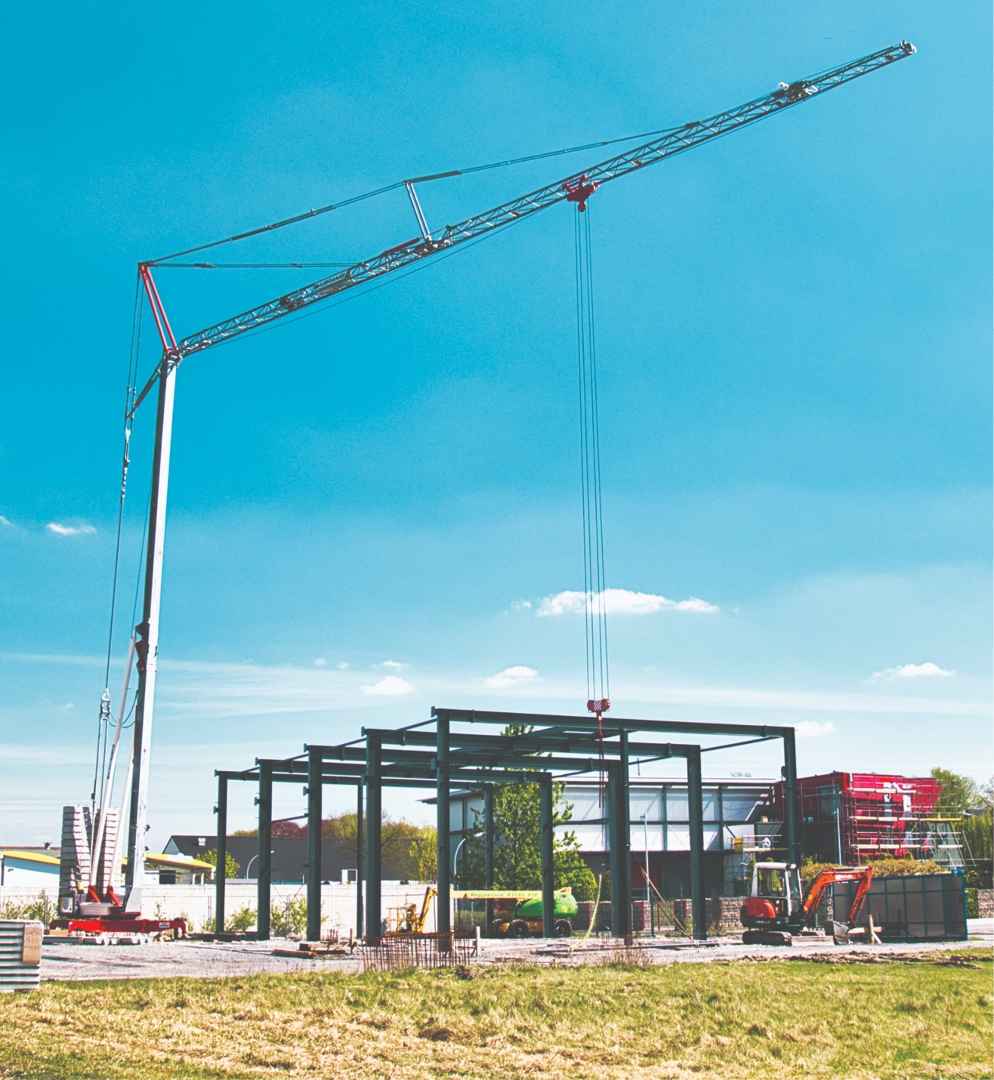
The users we consulted were mainly builders of wood-frame structures and crane rental companies whose clients include self-erector users.
Those experts included ACS, Phoenix, Arizona; Blossom Builders, Dillon, Colorado; Capital Framing, Greensburg, Kentucky; Ideal Crane Rental, Madison, Wisconsin and Jayko Cranes, Orem, Utah.
Solid, Growing Market
Everyone we talked with agreed that the market for self erectors is solid and growing, with a bright future as users in many sectors of construction discover the benefits offered by these rigs.
A Potain representative said that the market is growing steadily as customers look for faster, more efficient lifting solutions on constrained jobsites.
Andrew Stalter, business development manager for Morrow Equipment Co., said the market is growing steadily, with increasing traction in the urban infill, high-end residential, light commercial and modular construction sectors.
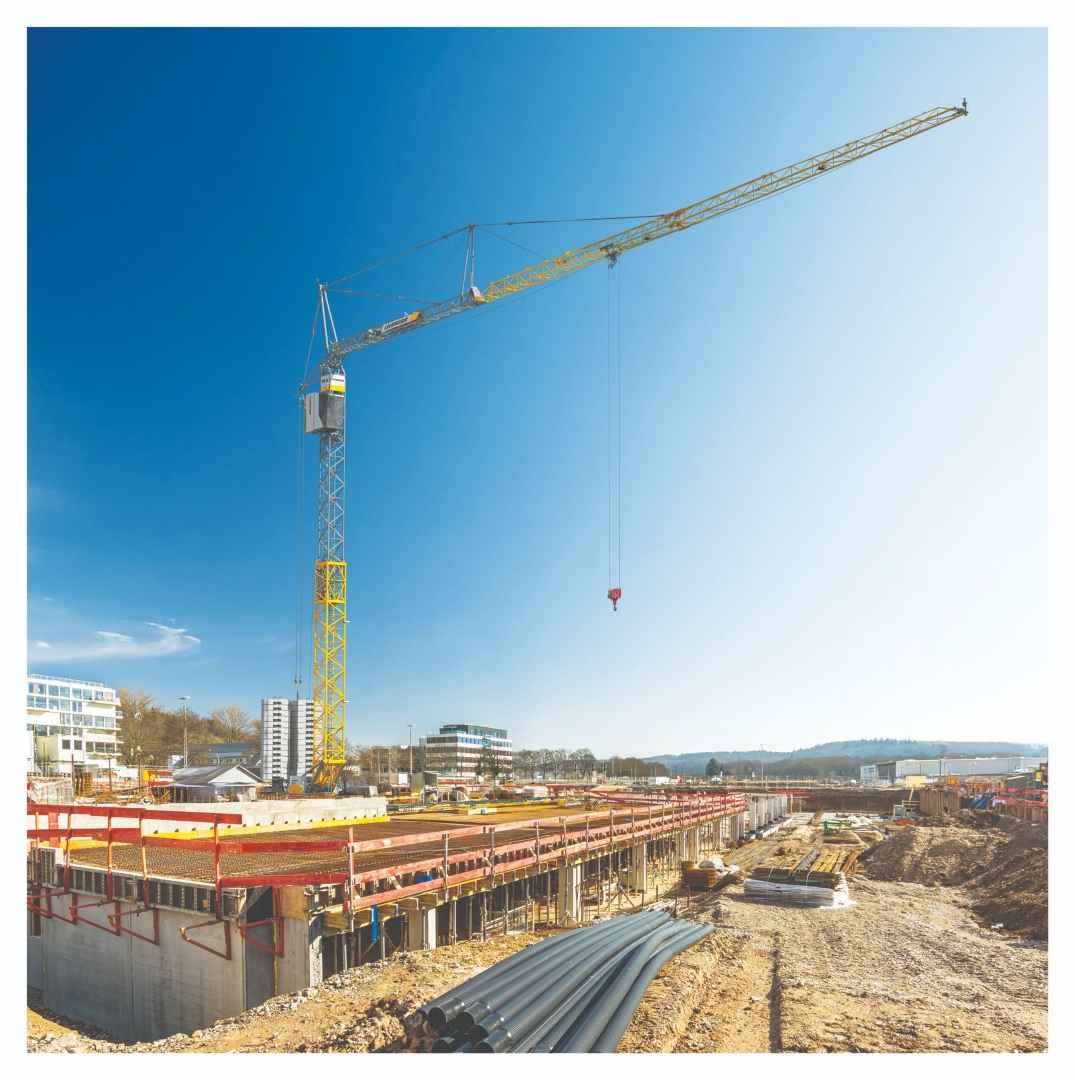
Added Lee Maynard, tower crane global sales director for Terex Cranes: “The North American market for self-erecting cranes is experiencing steady growth and is projected to continue growing through the next years.”
And Kelly Webb, vice president of Creative Lifting Services, noted, “Although we see more self-erecting cranes in use every day, the market for them is still far from reaching its full potential. There is plenty of room for growth. The work is there. The demand is there. We just need for more potential users to become aware of the benefits of the concept.”
Market Drivers
The market’s current activity and promising potential for further growth are being driven by at least three factors.
One is more construction of the kinds of buildings ideally suited for self-erecting cranes, for example mid-rise, wood-frame commercial or multi-family structures.
“An influx of multi-use/urban-living apartments and condos in recent years, as well as office space being transformed into condos, is providing work that’s well suited to self-erectors,” according to Compass Equipment’s Paul Autry.
And the Potain representative said that growth in urban infill projects, timber framing and modular construction are all contributing to the healthy market for self-erectors.
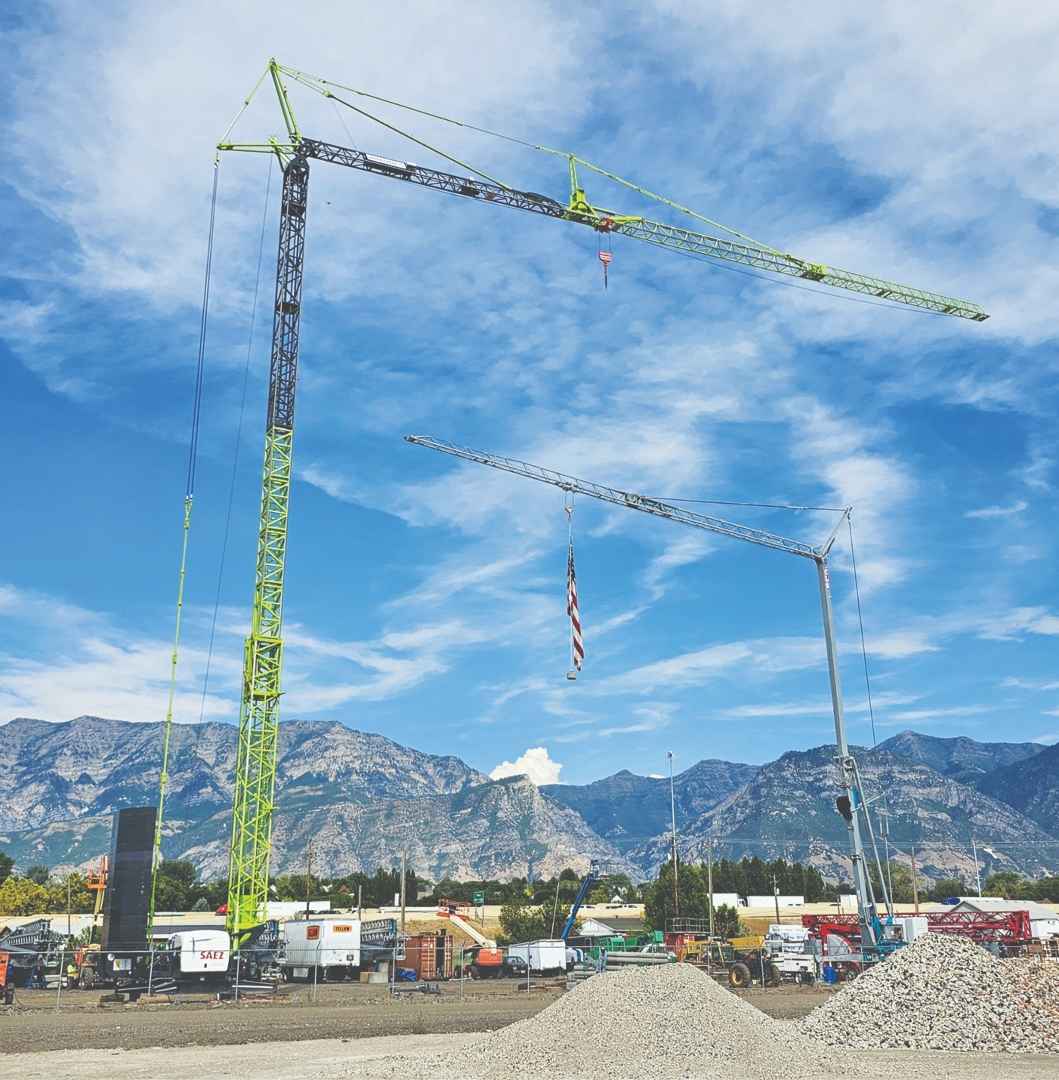
A second driver is expansion of self-erectors into new sectors of the industry, for example modular construction, prefab construction and infrastructure work.
“Self-erecting cranes are increasingly used in residential and mid-rise commercial construction, but also in infrastructure projects and as service cranes on major jobs,” said Terex’s Maynard.
And the third driver is growing awareness that self-erecting cranes can solve many challenges now common across all sectors of the lifting industry.
For example, everyone noted tight jobsites, condensed project schedules, labor shortages and the need to minimize costs.
“Using a self-erecting crane often helps reduce cost by reducing the need for manpower and by allowing the jobsite to run more safely and efficiently,” said Creative Lifting’s Webb.
Added Morrow’s Stalter, “Forward thinkers are starting to view self-erecting cranes as a more efficient alternative to traditional lifting equipment like telehandlers, rough-terrain cranes, and mobile cranes, particularly where space it tight.”
Stalter noted that besides reducing crew size, a self-erector often can boost productivity by being able to reach an entire project site from one spot and by being able to place materials right at the point of use rather than just over a roof parapet.
Insights From Users
Jayko Crane, Orem, Utah, rents boom trucks and self-erecting tower cranes to customers throughout the Intermountain West.
It also can provide customers with crane-related services like delivery, setup, moving, maintenance, accessories and certified training.
President Brandon Lloyd said that although Jayko serves a range of customers, the largest category of self-erector users is wood framers.
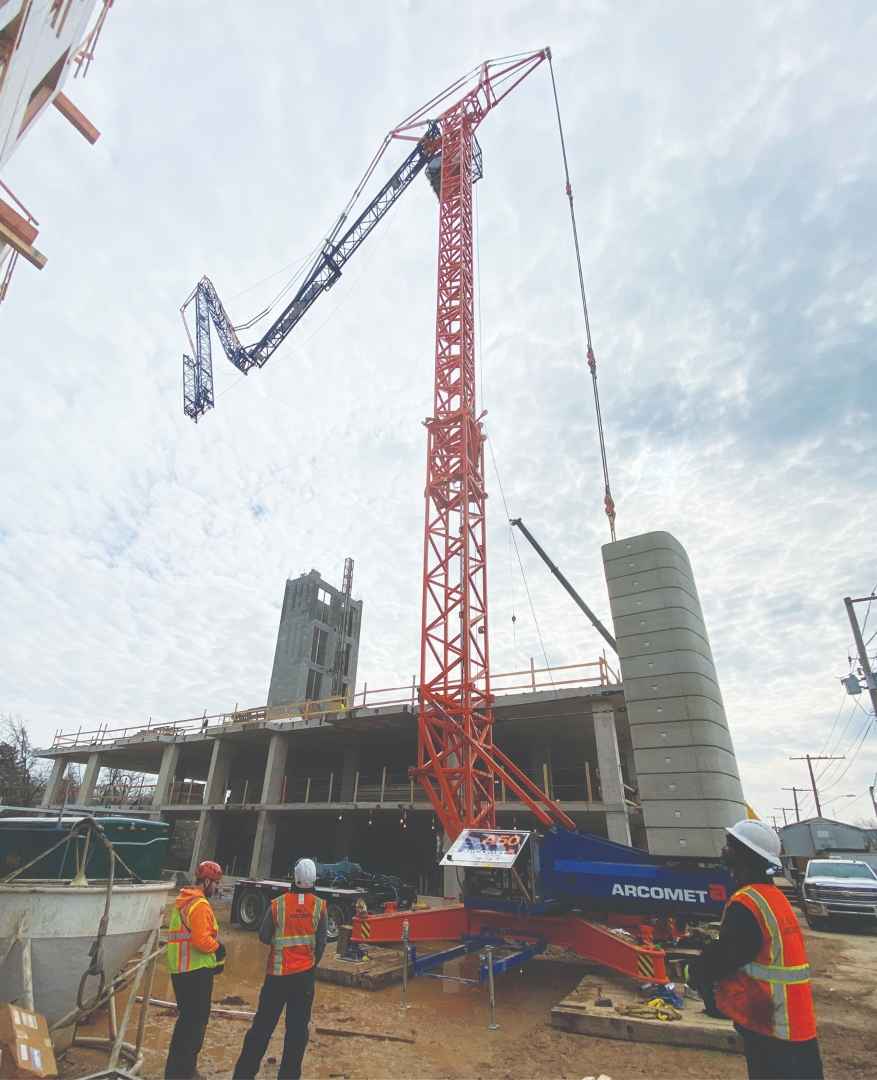
“A lot of buildings being built in Utah have one or two levels of concrete parking ramp topped by three to four levels of wood-framed commercial space and multi-family housing,” Lloyd said. “Self-erecting cranes are very efficient for that.”
One cornerstone of Jayko’s fleet is a Saez HT47 self erector it bought through Creative Lifting Services.
“We like that you can add sections to the HT47’s mast to make it taller when a job calls for it, and also that the crane can be transported with its full 154-foot jib installed and folded up,” said Lloyd.
Capital Framing LLC, Greensburg, Kentucky, specializes in wood framing for multi-story commercial, mixed-use and educational buildings, as well as multi-family housing.
Aaron Detweiler, who co-owns the company with his father, says Capital Framing’s 50 carpenters work mainly in central and northern Kentucky but also do projects in Indiana, Ohio and Tennessee.
The company owns a Potain Igo T 50 self-erector that Detweiler says is busy “almost continuously.” Capital Framing bought the unit from Compass Equipment.
“We always have several projects going at once,” said Detweiler. “We use a small rough-terrain crane on many of them, but for jobs that stand four or more stories tall or are 60 or more feet deep, the self-erecting crane is the best solution.”
He added that the crane is amazingly reliable and that its built-in safeguards protect both the machine and the operator.
“I also like that the wireless controls always let operators be where they can see the load,” said Detweiler.
ACS is an employee-owned wood-framing contractor that builds primarily multi-family projects in Arizona and California.
Its average project has about 250 units and covers about 300,000 square feet.
“We go as high as five levels of wood framing over four levels of concrete,” said Tyler Mussro, director of construction. “For buildings of three stories or less, we mostly use telehandlers, but where we don’t have ground-level access to all four sides or when the building is taller, we rent a self-erecting crane.”
Mussro said that those tower crane rentals typically last from two months to a year, depending on the project.
He also noted that ACS rents mostly Potain Igo T 85 or T85 A self-erectors because they can “lift a healthy load out at the jib tip.”
Mussro added that once a crane is on site, it handles all kinds of loads. “It lifts OSB, lumber, trash boxes, utility boxes and outhouses, plus does work for other trades like roofing and HVAC,” he said.
Mussro said that ACS is starting to use self-erectors more often than other lifting equipment.
“They’re proving to be faster and more cost-effective than forklifts and hydraulic cranes for logistically challenged projects,” he said.
Blossom Building LLC, Dillion, Colorado, is a home builder that often constructs high-end homes on scenic but difficult sites in the region’s mountains.
Andrew Blossom founded the company in 2019 after working as a carpenter for years and having been involved in construction since childhood.
He says that using self-erecting cranes has transformed the company’s culture and building techniques.
“We started using self-erectors three or four years ago and just bought an FB Gru 1589 last year,” Blossom said. “It gives us 89 feet of horizontal reach, 65 feet of hook height, 5,500-pound maximum capacity and more than 1,500-pound jib-tip capacity in a 14-foot-by-14-foot footprint.
“Using self-erectors has cut our crew size from eight people to three, including me,” said Blossom. “We no longer need to have a bunch of people on hand to manually muscle up walls or handle big pieces of fascia board.”
Blossom said that his small but highly motivated crew all enjoy coming to work, thanks in part to having a crane to do the bull work. “No one has called in sick in more three years,” he said. “And doing the heavy lifting with the crane takes the injury potential out of the job. It will enable these guys to have longer careers, and retire in better health.”
Blossom’s FB Gru 1589 comes to a jobsite as one load riding on its own axles and pulled by a semi tractor. Setup takes about 90 minutes, according to Blossom.
The Blossom crew works all year round, often at altitudes higher than 10,000 feet, so it sees lots of snow and ice.
“The crane is all electric, so the control is very accurate and the cold doesn’t affect it,” said Blossom. “We use it to place and empty snow tarps, unload delivery trucks and handle big structures like assembled gables and rake walls. On one job, we even set 135 tons of steel with it.”
Ideal Crane Rental, Madison, Wisconsin, clearly believes in the power of self-erectors.
Its founder and president Bob Kalhagen has put 20 Liebherr self-erectors into the company’s fleet and says they stay at about 70% utilization all year round, in spite of Wisconsin’s harsh winters.
“We have 16 81K.1s and four 125Ks,” said Kalhagen. “We use them on our projects and also bare-rent them to customers all over the state.”
Kalhagen says that the self-erectors work mainly on wood-frame multi-family housing, commercial and similar buildings, with most jobs taking place in Milwaukee, Madison and the Fox Valley along the west side of Lake Winnebago.
Ideal’s delivery system makes it easy for rental customers to get the self-erectors set up and working quickly.
“Our experienced set-up crew delivers and erects each crane, then familiarizes the customer’s crew with how it works,” said Kalhagen. “Though the cranes can self erect, we minimize setup time by using a small crane to handle and stack counterweight slabs.”
The crew can set up a self-erector in about four hours, and it erects an average of three to four rigs a week.
The forward-thinking Kalhagen has recently invested in a new twist on self-erecting cranes by buying four Liebherr MK Series cranes, which are essentially self-erectors mounted on truck-crane chassis.
Kalhagen says that since Ideal put the MK Series cranes to work in May 2024, they have been changing how customers think about self-erecting cranes.
“The MK cranes can travel on public roads, then set up and be working in as little as 30 minutes with all the same benefits as a standard self-erector, and in some cases up to 200 feet of outreach” said Kalhagen. “They will change the game on many jobs.”



